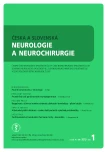The Use of Transcerebellar Approach with Inverted Frame Setting for Stereotactic Biopsy of Posterior Fossa Lesions
Authors:
J. Chrastina 1,2; Z. Novák 1,2; P. Cejpek 1; M. Hermanová 3; I. Říha 1,2; J. Vaníček 4,5
Authors‘ workplace:
Neurochirurgická klinika LF MU a FN U sv. Anny v Brně
1; CEITEC – Středoevropský technologický institut MU, Brno
2; I. patologicko-anatomický ústav LF MU a FN u sv. Anny v Brně
3; Klinika zobrazovacích metod LF MU a FN u sv. Anny v Brně
4; Mezinárodní centrum klinického výzkumu ICRC, Brno
5
Published in:
Cesk Slov Neurol N 2013; 76/109(1): 86-89
Category:
Short Communication
Overview
Structural lesions affecting posterior fossa region represent a less frequent indication for stereotactic biopsy since vital structures are concentrated in a confined space of posterior fossa and an approach is more demanding. Transfrontal (bioptic cannula inserted from frontal trephination), transtentorial (temporoparietal trephination, cannula passing through tentorial center) and direct transcerebellar approaches may all be used for biopsy sampling. The choice of the surgical approach depends on the location of the lesion with respect to the brainstem. The main limitation of the direct transcerebellar biopsy is the location of the frame directly over the suboccipital region that restricts the options for insertion of a cannula. Inverted stereotactic frame fixation can be used to overcome this technical limitation with subsequent cannula insertion below the frame. The paper analyses the use of the modified transcerebellar approach in four patients with lesions of unclear etiology affecting the posterior fossa structures. The modified transcerebellar stereotactic approach enabled safe bioptic sampling in all patients with decisive impact on further treatment.
Key words:
frame-based stereotaxy – biopsy – infratentorial tumor
Acceted for review:
21. 5. 2012
Accepted for print:
25. 7. 2012
Sources
1. Kreth FW, Muacevic A, Medele R, Bise K, Meyer T, Reulen HJ. The risk of haemorrhage after image guided stereotactic biopsy of intra-axial brain tumours – a prospective study. Acta Neurochir (Wien) 2001; 143(6): 539–545.
2. Woodworth G, McGirt MJ, Samdani A, Garonzik I, Olivi A, Weingart JD. Accuracy of frameless and frame based image guided stereotactic biopsy in the diagnosis of glioma: comparison of biopsy and open resection specimen. Neurol Res 2005; 27(4): 358–362.
3. Aung TH, Kwok CK, Mak YF, Mak EG. Computed tomography – guided stereotactic aspiration and biopsy of a cystic metastatic adenocarcinoma of the pons. HKMJ 1997; 3(2): 232–235.
4. Spiegelmann R, Friedman WA. Stereotactic suboccipital transcerebellar biopsy under local anesthesia using the Cosman-Roberts-Wells frame. Technical note. J Neurosurg 1991; 75(3): 486–488.
5. Sanai N, Wachhorst SP, Gupta NM, McDermott MW. Transcerebellar stereotactic biopsy for lesions of the brainstem and peduncles under local anesthesia. Neurosurgery 2008; 63(3): 460–466.
6. Amundson EW, McGirt MJ, Olivi A. A contralateral, transfrontal, extraventricular approach to stereotactic brainstem biopsy procedures. Technical note. J Neurosurg 2005; 102(3): 565–570.
7. Nádvorník P. Transtentorial dentatotomy. Exc Med International Congr Service 1973; 29 : 4.
8. Montes JL, Clarke DB, Grabb PA. Stereotactic transtentorial hiatus ventriculoperitoneal shunting for the sequestered fourth ventricle. J Neurosurg 1994; 80(4): 759–761.
9. Guthrie BL, Steinberg GK, Adler JR. Posterior fossa stereotaxic biopsy using Brown Robert Wells stereotaxic system. J Neurosurg 1989; 70(4): 649–652.
10. Harrison SE, Shooman D, Grundy PL. A prospective study on the safety and efficiacy of frameless, pinless electromagnetic image-guided biopsy of cerebral lesions. Neurosurgery 2012; 70 (1 Suppl Operative): 29–33.
11. Buchvald P, Suchomel P, Kaiser M. Chirurgické řešení ependymomů krční a hrudní míchy. Cesk Slov Neurol N 2007; 70/100(3): 117–124.
Labels
Paediatric neurology Neurosurgery NeurologyArticle was published in
Czech and Slovak Neurology and Neurosurgery

2013 Issue 1
- Metamizole vs. Tramadol in Postoperative Analgesia
- Memantine in Dementia Therapy – Current Findings and Possible Future Applications
- Metamizole at a Glance and in Practice – Effective Non-Opioid Analgesic for All Ages
- Advances in the Treatment of Myasthenia Gravis on the Horizon
Most read in this issue
- Use of Botulinum Toxin in Neurology
- Frequent Incidence of Lyme Neuroborreliosis in Children in the Czech Republic
- Tetanus – a Reborn Diagnosis? A Case Report
- Hydrocephalus as a Complication of Subarachnoid Hemorrhage
